Cryptocurrency enthusiasts are witnessing a paradigm shift in the way assets are traded, thanks to the rise of decentralized exchanges (DEX). In this article, we’ll explore the intricacies of these platforms, their advantages, challenges, and the evolving landscape of decentralized finance (DeFi).
Introduction
The cryptocurrency market has evolved significantly over the years, and decentralized exchanges have emerged as a game-changer. Unlike traditional centralized exchanges that rely on intermediaries, DEX operates on a peer-to-peer network, providing users with unparalleled security and privacy.
Advantages of Decentralized Exchanges
Security and Privacy
One of the primary advantages of DEX is enhanced security and privacy. Users retain control of their private keys, reducing the risk of hacks and unauthorized access common in centralized exchanges.
Elimination of Intermediaries
Decentralized exchanges eliminate the need for intermediaries, allowing users to trade directly from their digital wallets. This not only streamlines the trading process but also minimizes associated fees.
Reduced Risk of Hacking
With no centralized servers vulnerable to single points of failure, DEX significantly reduces the risk of hacking. Users can trade with confidence, knowing their assets are secured by robust blockchain technology.
Best Decentralized Exchanges
Decentralized exchanges come in various forms, but a few have stood out in the crypto community:
Uniswap
Uniswap, a trailblazer in the realm of decentralized exchanges (DEX), stands out as an automated market maker (AMM) protocol entrenched within the Ethereum blockchain. This platform empowers users to effortlessly exchange an array of ERC-20 tokens, eliminating the necessity for intermediaries. Uniswap operates through the ingenious use of liquidity pools, departing from traditional order books. This methodology ensures a perpetual stream of liquidity and minimal slippage, enhancing the trading experience for participants. Integral to the Uniswap ecosystem, the UNI token assumes a pivotal role by facilitating governance decisions and bestowing liquidity providers with a portion of transaction fees as a reward.
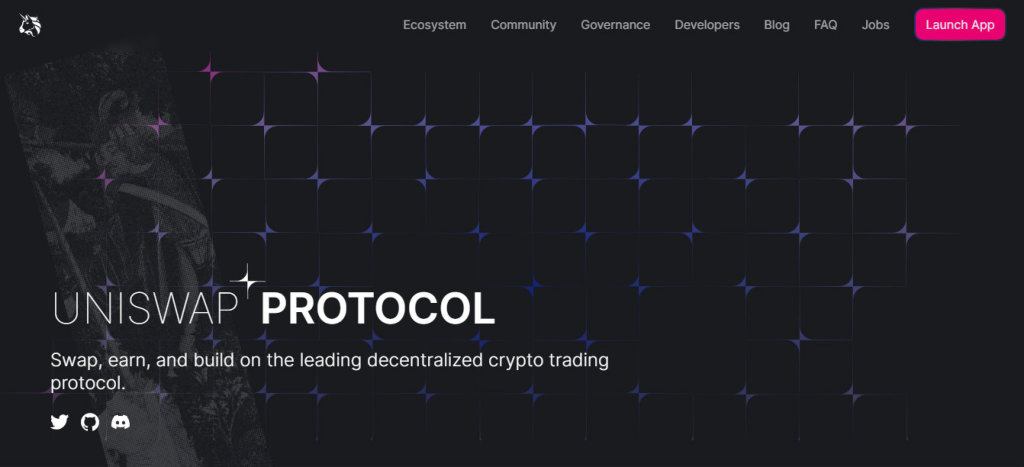
Uniswap boasts several key features that set it apart in the decentralized exchange (DEX) landscape:
Automated Market Maker (AMM): Uniswap adopts the AMM model, revolutionizing trades through predefined smart contract algorithms rather than traditional order books. This approach enhances accessibility and liquidity, allowing users to execute trades directly from their wallets without requiring a counterparty.
Liquidity Pools: At the core of Uniswap’s functionality are liquidity pools, where users contribute tokens to establish liquidity for specific trading pairs. These pools form the foundation of the exchange, ensuring a continual and decentralized supply of liquidity.
Consistent Liquidity & Minimal Slippage: The incorporation of liquidity pools guarantees a constant availability of liquidity for trades. This mechanism minimizes slippage, offering users a more predictable trading experience, even with larger transactions.
UNI Token: The UNI token plays a pivotal role within the Uniswap ecosystem. It serves a dual purpose by facilitating governance participation, granting the community a voice in the platform’s development. Simultaneously, it distributes a portion of transaction fees to liquidity providers, incentivizing their active involvement.
Uniswap’s impact on the decentralized finance (DeFi) landscape is noteworthy. Its innovative approach to decentralized trading has paved the way for numerous other DEXs and DeFi applications, reshaping how users engage with cryptocurrencies and inspiring continuous advancements in the blockchain sphere.
| Pros | Cons |
| Offers more than 400 tokens | No fiat transactions |
| A large, reputable, and established exchange platform | The risk of impermanent loss is always present |
| High trading volume | Gas fees |
| DAO-governed | |
| Users can generate passive earnings through staking | |
| Transaction fees from 0.1% to 1% |
PancakeSwap
PancakeSwap exchange emerges as a decentralized exchange (DEX) constructed on the Binance Smart Chain (BSC), strategically crafted to present a swifter and more economical choice compared to Ethereum-based DEXs. It mirrors the operational features akin to Uniswap but distinguishes itself through diminished transaction fees and expedited confirmation times. The native utility token of PancakeSwap, known as CAKE, plays a pivotal role in governance, and staking, and allows users to earn a portion of the platform’s fees.
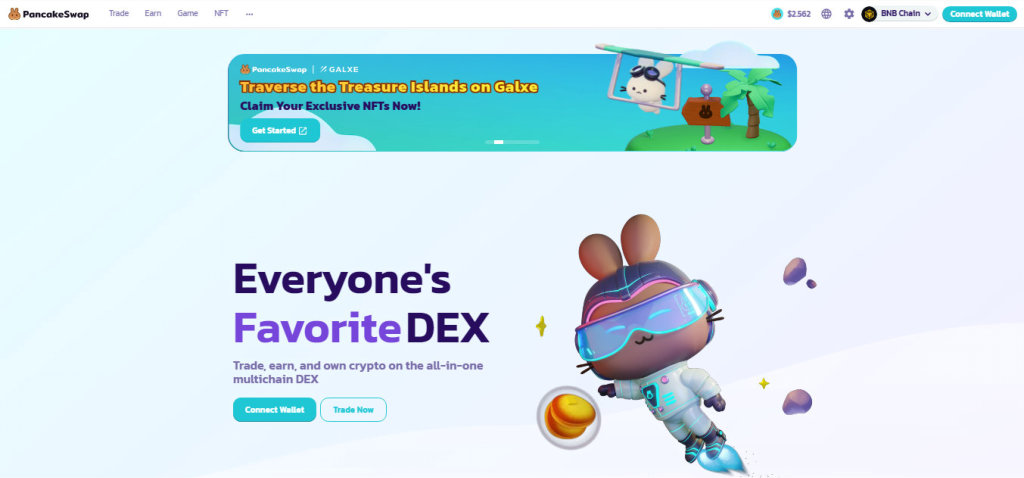
PancakeSwap, a standout in the decentralized exchange (DEX) arena, boasts distinctive features:
Binance Smart Chain (BSC) Integration: PancakeSwap’s seamless integration with the Binance Smart Chain remains integral to its triumph. Capitalizing on BSC, the platform guarantees expeditious transaction confirmations and substantially diminished fees in contrast to Ethereum-based DEXs. This integration not only facilitates efficient trading but also broadens the user base.
CAKE Token: At the heart of PancakeSwap’s ecosystem is the native utility token, CAKE. This token assumes a pivotal role as holders enjoy governance rights, empowering them to propose and vote on changes, influencing the platform’s evolution. Additionally, CAKE holders can stake their tokens, reaping rewards and a share of the platform’s trading fees—a mechanism designed to encourage active engagement.
Familiar AMM Model: PancakeSwap aligns with the Automated Market Maker (AMM) model, reminiscent of Uniswap. This model ensures perpetual liquidity through liquidity pools, allowing users to seamlessly exchange various BEP-20 tokens. Liquidity providers, in turn, earn a share of trading fees commensurate with their stake in the liquidity pool.
Farms and Syrup Pools: Introducing ‘Farms’ and ‘Syrup Pools,’ PancakeSwap incentivizes users to contribute liquidity and stake CAKE tokens. Participation in these pools enables users to earn CAKE rewards, fostering a vibrant and engaged community.
PancakeSwap’s ascent as a premier decentralized crypto exchange on the Binance Smart Chain underscores the significance of scalability and cost-effectiveness in the DeFi space. By emulating the proven AMM model and augmenting it with reduced fees and swift transactions, PancakeSwap has not only attracted a substantial user base but has also solidified its position as a pivotal player in the dynamic DeFi landscape.
| Pros | Cons |
| More than 50 supported DeFi tokens | Possibility of impermanent loss |
| Low transaction fees | |
| Slippage risks are significantly reduced |
SushiSwap
SushiSwap stands out as a prominent decentralized exchange (DEX) within the cryptocurrency industry. Stemming from Uniswap, it rightfully earns its place among the elite decentralized exchanges for numerous compelling reasons. At the core of its ecosystem is the native token, SUSHI, providing users with opportunities for passive earnings through staking. Users not only enjoy various governance benefits but also benefit from SushiSwap’s distinctive DEX architecture, actively working to diminish the market’s centralization.

SushiSwap distinguishes itself through key features:
Community-Driven Model: At the core of SushiSwap lies its community-driven ethos, encouraging active participant involvement in decision-making processes. This approach instills a sense of ownership and decentralization, allowing users to propose and vote on platform changes, upgrades, and protocols. This ensures that the platform’s evolution aligns with the collective vision of its user base.
SUSHI Token: The implementation of the SUSHI token serves as a powerful incentive for liquidity providers within the SushiSwap ecosystem. Liquidity providers receive a proportional share of the platform’s fees based on the liquidity they contribute. Holding SUSHI tokens also grants users voting rights in the platform’s governance, empowering them to shape its future.
Enhanced Features: SushiSwap goes beyond its predecessor, Uniswap, by introducing enhancements such as increased rewards for liquidity providers, reduced fees, and improved capital efficiency through features like ‘Onsen’ and ‘Kashi.’ These improvements are strategically designed to attract users and liquidity while fostering a sustainable and thriving DeFi ecosystem.
Migration and AMM: SushiSwap’s migration feature enables users to seamlessly transfer their liquidity and LP tokens from Uniswap to SushiSwap. Operating on an Automated Market Maker (AMM) model, similar to Uniswap, ensures efficient and seamless trading experiences through liquidity pool utilization.
SushiSwap’s rapid ascent underscores the significance of community governance and incentives in the DeFi realm. By leveraging Uniswap’s success and elevating its features, SushiSwap not only enhances the DEX experience for users but also exemplifies the transformative potential of community-driven initiatives in shaping the DeFi landscape.
| Pros | Cons |
| Low transaction fees | Complicated rewards structure |
| Works with most ERC-20 tokens | Limited in cutting-edge technology |
| Highly intuitive interface |
1inch
1inch stands out as an effortless crypto trading platform, recognized as the premier DEX aggregator. Pioneering seamless transactions, the platform conducts a comprehensive scan across multiple DEXs before each transaction, enabling users to capitalize on the most favorable prices when acquiring tokens. The inclusion of a dynamic liquidity pool offers users the opportunity to stake tokens, unlocking rewards distributed in the form of the 1INCH token. Holding onto these native tokens not only yields rewards but also grants users influential voting rights within the platform’s governance.
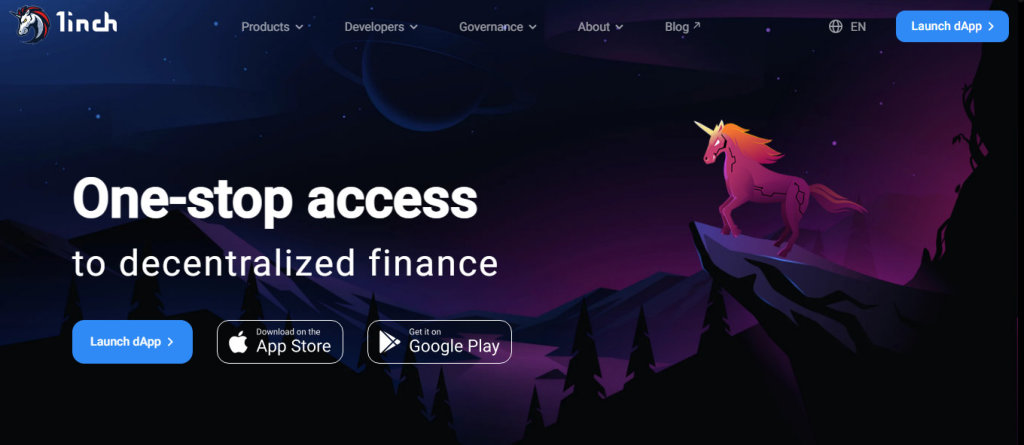
1inch exchange boasts distinctive features that set it apart:
Intelligent Routing: 1inch’s algorithm considers liquidity, fees, and price impact for optimal trade paths, delivering the best rates and optimizing user experiences.
1INCH Governance Token: The core, 1INCH, empowers holders in decentralized decision-making. Token holders suggest changes, enjoy fee discounts, and get ownership incentives.
Enhanced User Experience: 1inch simplifies DeFi trading with a user-centric design, intuitive interface, and efficient mechanisms for seamless access to multiple DEX advantages.
1inch’s DEX aggregation innovatively addresses liquidity challenges, empowering users for optimized and informed trading. The 1INCH token ensures a community-driven and decentralized evolution.
| Pros | Cons |
| More than 400 tokens on offer | Other DEXs might charge transaction fees |
| Zero transaction fees | May be difficult for new traders to use |
| 1INCH holders can participate in governance | |
| Excellent exchange rates |
Balancer
Next on the list is another Ethereum-based decentralized exchange known as Balancer. This platform is distinguished for its swift execution of trades facilitated by smart contracts and liquidity pools. Functioning as an Automated Market Maker (AMM), Balancer extends a range of liquidity pools to users. Remarkably, users have the flexibility to create their pools, choosing from three distinct types: smart pools, private pools, and shared pools. This feature-rich platform provides a dynamic and customizable trading experience within the decentralized finance (DeFi) landscape.
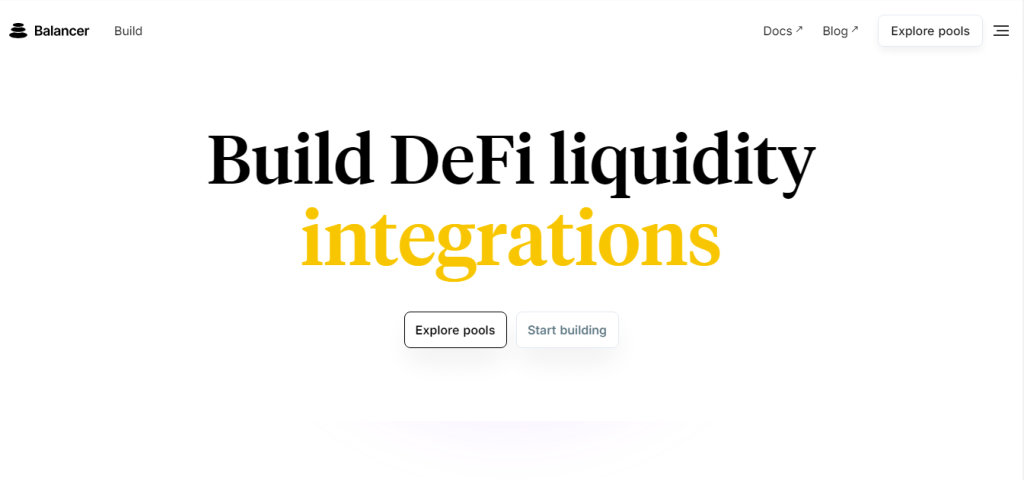
Balancer introduces distinctive features that redefine decentralized finance (DeFi):
Tailored Liquidity Pools: Balancer empowers users to craft liquidity pools with diverse tokens, each assigned unique weightings. This level of customization allows for intricate pool structures, enticing a broad user base, from DeFi enthusiasts to sophisticated investors seeking personalized portfolio exposure.
Intelligent Portfolio Management: The flexibility to set custom weights facilitates intelligent portfolio management within a single Balancer pool. Users can automatically rebalance their portfolios based on prevailing market conditions, ensuring the maintenance of their preferred asset allocation. This dynamic feature caters to investors seeking enhanced control and adaptability in managing assets within the DeFi ecosystem.
Balancer Governance (BAL) Token: At the core of Balancer’s governance and economic model lies the BAL token. BAL holders actively engage in platform governance, proposing and voting on protocol changes. Liquidity providers receive BAL tokens as incentives, fostering active participation and contributing to the network’s liquidity.
Fee Earnings and BAL Rewards: Liquidity providers not only earn fees from trades within the pool, distributed based on the pool’s weights but also receive BAL tokens, augmenting their overall rewards. This dual incentive structure encourages users to actively contribute to liquidity provision and engage in the governance of the Balancer protocol.
Balancer’s groundbreaking approach to liquidity provision introduces unparalleled flexibility and customization in the DeFi space. Enabling users to construct pools with diverse tokens and varied weights, Balancer reshapes portfolio management in decentralized finance. This innovative concept attracts a diverse audience, highlighting the platform’s adaptability and its potential to redefine the future of DeFi.
| Pros | Cons |
| Gas-free payments despite being on Ethereum | Transaction fees can vary depending on pool owners, going from 0.0001% to 10% |
| Multiple pool types to choose from when creating your own pool | |
| Quick and easy to use | |
| It lets you generate passive earnings |
dYdX
dYdX stands out as a decentralized exchange with a primary focus on perpetual trading options, specifically specializing in a unique form of derivative trade.
Perpetual futures contracts on dYdX allow investors to place buy or sell orders at a fixed price indefinitely, eliminating the need for expiry dates typical in other futures contracts. dYdX caters to users with more than 35 different cryptocurrencies, offering them the ability to engage in these perpetual trades with up to 20X leverage. Notably, all trades on dYdX are executed using smart contracts, setting it apart from centralized exchanges.
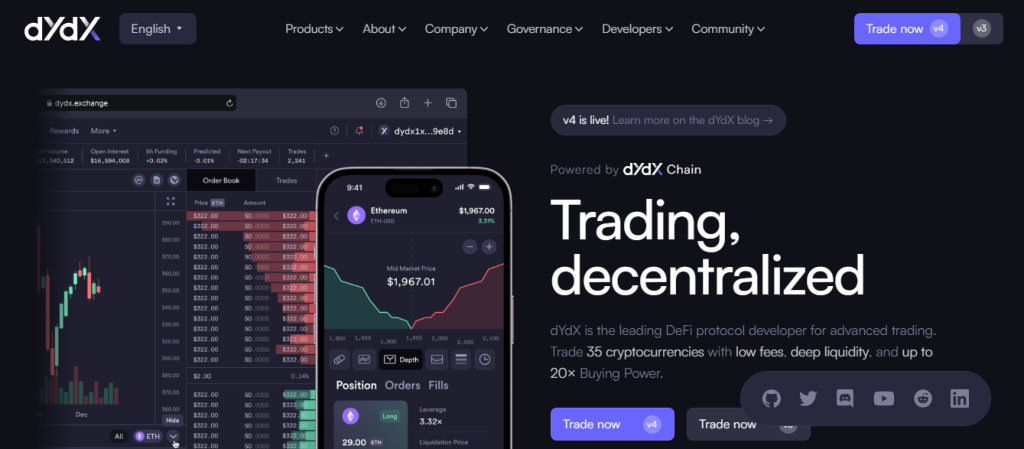
Additionally, dYdX introduces its native token – DYDX. Users can acquire DYDX in a manner similar to any other token purchase. Furthermore, engaging in trading activities using the protocol allows users to earn DYDX tokens, and staking DYDX enables users to earn a yield.
It’s essential to recognize that dYdX operates as a hybrid decentralized exchange. While the project initially aimed for full decentralization, most components of the exchange have achieved that status. The remaining centralized aspects are slated for removal in the upcoming dYdX V4 release, solidifying its commitment to a fully decentralized model.
dYdX key features:
TVL: $352 million
Supported chains: 1
Governance token: DYDX
| Pros | Cons |
| User-friendly | No fiat deposits |
| Second-highest trading volume among DEXs | Limited trading options |
| It has a mobile app | |
| The trading fee is only 0.1% | |
| Offers trading with leverage | |
| It lets you generate passive earnings in multiple ways |
OKX DEX
Introducing OKX DEX, a versatile cross-chain, multi-chain DEX aggregator designed to optimize user transactions across an extensive network of 20+ chains, 300+ DEXs, and a staggering 200,000+ coins. Positioned as a decentralized and borderless trading platform, OKX DEX prioritizes security and operates on a non-custodial model.
OKX DEX ensures users a seamless trading experience coupled with comparatively low trading fees. Its focus extends beyond providing a dedicated infrastructure, aiming to outshine Ethereum in terms of performance. This emphasis makes OKX DEX an alluring choice for various blockchain products, including DApps and DEXs, showcasing its commitment to delivering an enhanced trading environment.

Features
- Automatically find liquidity pools with the maximum on-chain liquidity depth
- Comprehensively calculate price, slippage, and transaction costs
- Select the best quote for users based on a comprehensive comparison of quotes from various DEXs and PMMs through the smart order-splitting algorithm
| Pros | Cons |
| Effortless Transactions: Quick and smooth transactions. | High Delay: Operations may have a delay. |
| User Satisfaction: Happy users with easy and speedy operation. | No Portuguese BR Community: Limited accessibility. |
| Great Design: Awesome and comfortable user interface. | Initial Site Confusion: New users might find navigation confusing. |
| Fantastic Exchange: Recognized for substantial earnings. | Logout Difficulty: Locating logout option can be a challenge. |
| User-Friendly: Easy exploration of product lines. |
Curve
Curve stands out as a favored decentralized exchange (DEX) catering to those seeking secure transactions with stablecoins and pegged cryptocurrencies, including wBTC, through a decentralized protocol.
Initially designed for Ethereum, Curve has expanded its support to encompass 10 additional blockchains, such as Avalanche, Fantom, Moonbeam, and Gnosis.
Beyond facilitating stablecoin swaps, Curve allows investors to provide liquidity to the protocol, earning rewards through trading fees.
The platform introduces its native token – CRV. Users can acquire CRV through purchase or by contributing liquidity to specific pools. Furthermore, staking CRV tokens on various yield farming protocols, like Convex Finance, presents an opportunity to amplify rewards.
Similar to other DeFi protocols, initiating trades involving stablecoins and pegged assets on Curve involves connecting to the DEX using a non-custodial wallet.
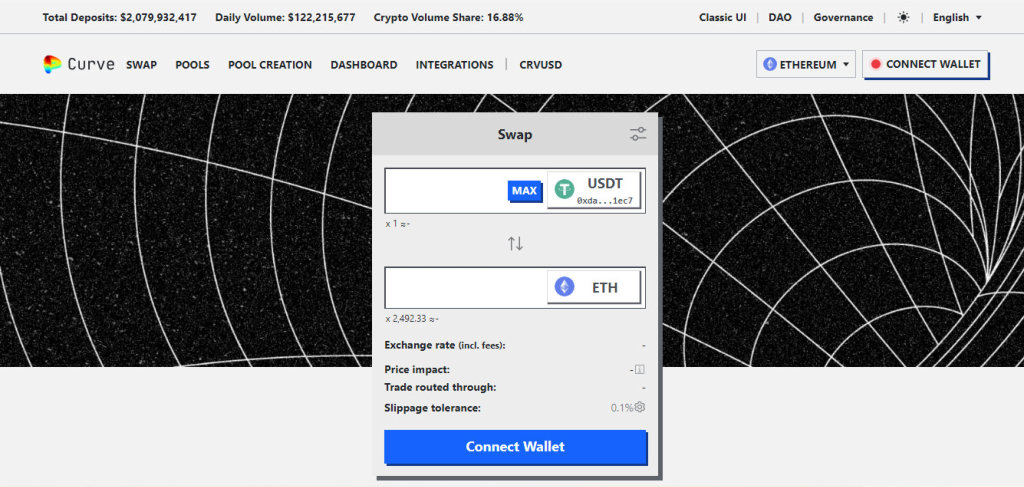
Key features of Curve
- Diverse Liquidity Pools: Curve offers a variety of liquidity pools, allowing users to select the pool that aligns with their risk preferences and the specific coins they are interested in.
- Swift Wallet Connectivity: Experience seamless and quick wallet connections with Curve. The platform ensures a hassle-free process, and it is compatible with multiple wallets for added convenience.
- Comprehensive Statistics: Gain access to a wealth of statistics at your fingertips. Curve provides users with daily metrics, coin volumes, and insights into cross-pairs, all accessible with just a few clicks.
| Pros | Cons |
| Diverse Token Selection: Provides access to a broad range of over 45 tokens. | Complex Interface Learning Curve: Users may face challenges due to a steep learning curve attributed to the platform’s intricate interface. |
| Low Transaction Fees: With transaction fees approximately at 0.04%, it offers cost-effective trading. | Elevated Gas Fees: High gas fees pose a drawback for users on the platform. |
| Token Holder Voting: Token holders have the privilege of participating in crucial decision-making processes. |
Bancor
Introducing Bancor — a distinguished decentralized exchange (DEX). Bancor, a pioneer in automated market makers (AMMs), emerged on the Ethereum scene back in 2017. Renowned for its immediate trade finalization and automatic liquidity, Bancor stands out as one of the premier decentralized exchanges for a multitude of traders. The native token, BNT, further enhances the platform by facilitating swift and seamless payments.
Bancor goes a step further in averting impermanent loss through its staking mechanism, available across multiple pools. Both staking rewards and BNT contributions yield exceptional returns. Notably, optimal rewards are reaped by users who engage in simultaneous staking of BNT and other cryptocurrencies.

Features of Bancor:
Decentralized Token Exchange: Bancor provides a decentralized platform for users to exchange various ERC-20 tokens without relying on intermediaries or central authorities.
Cross-Blockchain Compatibility: Built on both the Ethereum and EOS blockchains, Bancor offers flexibility and compatibility across multiple blockchain networks.
Bancor Formula: The platform utilizes the Bancor Formula, a unique automated pricing mechanism, eliminating the need for a centralized exchange. This enables users to trade tokens at any time, fostering accessibility.
Secure Trading with Smart Contracts: Bancor leverages smart contracts on the Ethereum blockchain, ensuring a secure and transparent trading environment protected against potential security threats.
User-Friendly Interface: Designed with user accessibility in mind, Bancor provides an intuitive interface, making token trading accessible even for non-technical users.
Liquidity Pools: Users can create liquidity pools, staking tokens to earn rewards for providing liquidity to the exchange, enhancing overall liquidity on the platform.
BNT Token Economy: Bancor Network Token (BNT) serves as the native token, offering benefits such as creating liquidity pools, transaction fee discounts, and participation in platform governance.
Automatic Token Pricing: The Bancor Formula, utilizing BNT, automatically determines token prices, ensuring liquidity and enabling continuous trading even in the absence of many buyers or sellers.
Buyback and Burn Programs: Bancor regularly conducts buyback and burn programs for BNT, increasing the token’s value and allowing holders to benefit from the platform’s growth.
Smart Contract Technology: Bancor’s use of smart contracts, including the Bancor Formula and liquidity pools, provides transparency and independence to users participating in the ecosystem.
| Pros | Cons |
| Automated Market Making (AMM) without order books | Past security issues, including smart contract vulnerabilities |
| Supports a wide range of Ethereum and EOS tokens | Lower liquidity may lead to price slippage |
| Unique liquidity pool model with staking for revenue | Primarily focuses on ERC-20 and EOS tokens |
| Single-token exposure without requiring a paired asset | Complex smart token mechanism for beginners |
| BNT token for cross-chain conversions | Potentially higher fees compared to some decentralized exchanges |
KyberSwap
KyberSwap secures the ninth spot on our roster of top decentralized exchanges. While operating similarly to other DEX platforms, Kyberswap distinguishes itself through unique modifications. Unlike traditional DEXs like Uniswap, Kyberswap functions as an aggregator. This means that it leverages multiple liquidity pools, sourcing liquidity from other DEXs supported by the network.
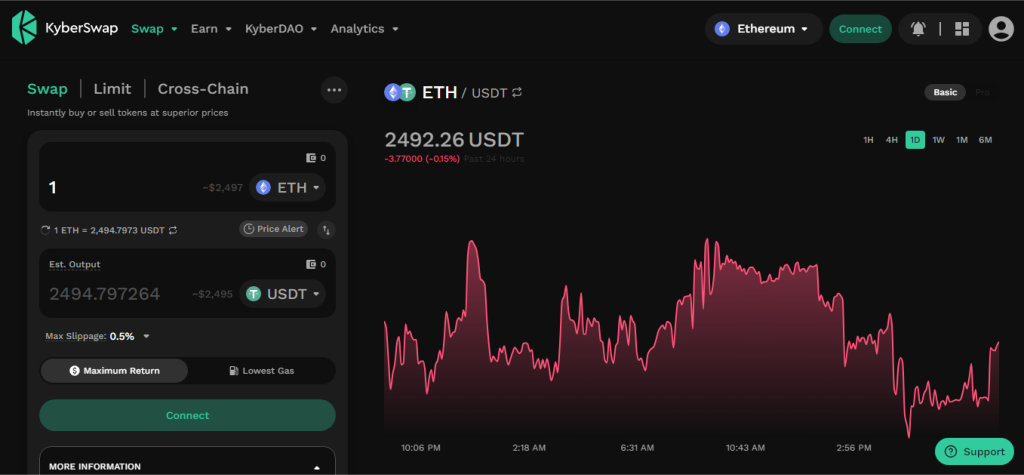
Features:
- Optimal rates for traders
- Superior returns/yields for Liquidity Providers (LPs)
- Enhanced reliability and security
- Completely unrestricted and permissionless
| Pros | Cons |
| They facilitate seamless trading within popular wallets, enabling users to trade directly from their wallet applications. | Kyber has limitations concerning assets not built on the Ethereum network. |
| Kyber Swap accommodates over 70+ ERC Tokens, expanding the variety of supported assets. | Gas fees are subject to fluctuations based on network traffic, impacting transaction costs. |
| For added convenience, a mobile application is available, facilitating easy trading and portfolio tracking. |
How Decentralized Exchanges Work
Understanding the inner workings of DEX is crucial for users looking to navigate these platforms seamlessly.
Smart Contracts
Smart contracts play a pivotal role in facilitating trustless transactions on DEX. These self-executing contracts automatically execute trades when predefined conditions are met, ensuring a transparent and efficient trading process.
Liquidity Pools
Decentralized exchanges operate based on liquidity pools, where users contribute their funds for trading. Liquidity providers earn fees, and the pools ensure there’s always liquidity available for users looking to trade.
Automated Market Makers (AMMs)
AMMs, like those on Uniswap, use algorithms to determine asset prices based on the ratio of assets in a liquidity pool. This automated approach allows for continuous trading without relying on traditional order books.
Challenges Faced by Decentralized Exchanges
While DEX offers numerous advantages, they are not without challenges.
Liquidity Issues
Some DEX platforms face liquidity challenges, especially with newer or less popular tokens. This can result in higher slippage and less favorable trading conditions.
User Interface Challenges
The user interfaces of certain decentralized exchanges may be less intuitive for beginners, potentially hindering adoption. Improving user experience remains a focus for developers in the space.
Regulatory Concerns
As the popularity of decentralized exchanges grows, regulatory scrutiny also increases. Navigating the evolving regulatory landscape is crucial for the sustained success of DEX.
Future Trends in Decentralized Exchanges
The DEX landscape is evolving rapidly, with several trends shaping the future of these platforms.
Integration of Layer 2 Solutions
To address scalability issues, DEX platforms are increasingly integrating Layer 2 solutions, enhancing transaction speed and reducing costs.
Cross-Chain Interoperability
The ability to trade assets across different blockchains is gaining traction. Cross-chain interoperability will enable users to access a broader range of assets seamlessly.
Enhanced User Experience
Developers are focusing on improving user interfaces and overall user experience to make decentralized exchanges more accessible to a broader audience.
Decentralized Finance (DeFi) and DEX
The relationship between DeFi and DEX is symbiotic, with DEX playing a crucial role in the decentralized finance ecosystem.
The Symbiotic Relationship
Decentralized exchanges provide the infrastructure for decentralized finance applications to thrive. The seamless swapping of tokens on DEX enhances the functionality of various DeFi projects.
DEX’s Role in the DeFi Exchanges
Comparison with Centralized Exchanges
Decentralized exchanges and centralized exchanges each have their unique strengths.
Speed and Efficiency
Centralized exchanges often boast faster transaction speeds due to their centralized infrastructure. However, DEX platforms are catching up, leveraging technological advancements to enhance transaction speed and efficiency.
User Control and Ownership
Decentralized exchanges prioritize user control and ownership of assets. Users retain custody of their private keys, reducing the risk of funds being held by a third party, a common concern with centralized exchanges.
Risks Associated with Decentralized Exchanges
Understanding the risks associated with DEX is essential for informed decision-making.
Impermanent Loss
Liquidity providers may experience impermanent loss due to price fluctuations. However, the long-term benefits, such as earning fees and governance rights, often outweigh these potential losses.
Smart Contract Vulnerabilities
While smart contracts are designed to be secure, vulnerabilities can still arise. Users should be cautious and choose platforms with a strong track record of security.
Market Manipulation
As with any financial market, decentralized exchanges are susceptible to market manipulation. Users should stay informed and exercise caution, especially when dealing with low-liquidity assets.
Tips for Choosing the Best Decentralized Exchange
Navigating the diverse landscape of decentralized exchanges requires careful consideration.
Research and Due Diligence
Thoroughly research each platform, including its history, security measures, and user feedback. Due diligence is crucial to choosing a reliable DEX.
User Reviews and Community Feedback
Consider user reviews and community feedback. Platforms with an active and supportive community often indicate a more reliable and user-friendly experience.
Security Features
Prioritize platforms with robust security features, such as two-factor authentication and secure smart contract architecture. Security should be a top consideration when choosing a DEX.
Decentralized Exchanges and Token Swapping
Understanding the process of token swapping on DEX is key for users looking to diversify their crypto portfolios.
The Process of Swapping Tokens
Token swapping on DEX involves selecting the desired tokens and confirming the transaction through a decentralized application (DApp). The smart contract executes the trade automatically.
Benefits of Token Swapping on DEX
Token swapping on DEX platforms offers lower fees, increased privacy, and faster transaction confirmation compared to traditional exchanges. This process empowers users to have more control over their assets.
Case Studies: Successful Decentralized Exchange Projects
Examining successful case studies provides insights into the growth and potential of DEX platforms.
Case Study 1: Uniswap’s Growth Journey
Uniswap’s innovative use of AMMs catapulted it to success. Constant development and community engagement have contributed to its widespread adoption and continuous growth.
Case Study 2: PancakeSwap’s Unique Features
PancakeSwap’s focus on low fees and fast confirmation times, coupled with features like staking and yield farming, has positioned it as a prominent player in the DEX space.
Decentralized Exchanges and Decentralized Autonomous Organizations (DAOs)
The integration of DAOs enhances governance and decision-making within DEX platforms.
The Role of DAOs in Governance
DAOs allow users to participate in decision-making processes, such as protocol upgrades and fee structures. This decentralized approach fosters a sense of community ownership.
Decentralized Decision-Making in DEX
Decisions related to platform upgrades and changes are often made through community voting, ensuring a democratic and transparent governance model.
The Impact of Decentralized Exchanges on Traditional Finance
The influence of DEX on traditional finance is becoming increasingly apparent.
Changing Dynamics in the Financial Sector
The rise of DEX challenges the traditional financial sector by offering a more accessible, inclusive, and decentralized alternative. This shift could potentially redefine the financial landscape.
The Potential for Widespread Adoption
As DEX platforms continue to evolve and address challenges, the potential for widespread adoption grows. Mainstream acceptance could lead to increased financial inclusivity and innovation.
Conclusion
In conclusion, decentralized exchanges represent a revolutionary shift in the way cryptocurrencies are traded. The advantages of enhanced security, reduced intermediaries, and user control make DEX platforms an attractive option for both seasoned and novice traders.
As the decentralized finance space continues to evolve, DEX platforms are likely to play a pivotal role in shaping the future of finance. Embracing technological trends, addressing challenges, and fostering user-friendly experiences will contribute to the sustained growth of decentralized exchanges.
Frequently Asked Questions (FAQs)
What sets Decentralized Exchanges (DEX) apart from traditional exchanges?
Decentralized Exchanges operate on a peer-to-peer network, eliminating the need for intermediaries. Users have enhanced security and privacy as they retain control of their private keys. DEX platforms facilitate direct trading from digital wallets, reducing fees and the risk of hacking associated with centralized exchanges.
How do Automated Market Makers (AMMs) function on DEX platforms like Uniswap and SushiSwap?
AMMs, such as those on Uniswap and SushiSwap, leverage algorithms to determine token prices based on liquidity pool ratios. This automated approach, in contrast to traditional order books, ensures continuous and decentralized trading. Liquidity providers contribute tokens to these pools, earning rewards and enhancing overall platform liquidity.
What challenges do Decentralized Exchanges face, and how are they addressing them?
Challenges include liquidity issues, user interface complexities, and regulatory concerns. DEX platforms are addressing these by implementing innovative features, enhancing user interfaces for accessibility, and staying proactive in navigating evolving regulatory landscapes.
How does Decentralized Finance (DeFi) intersect with Decentralized Exchanges?
DEX platforms form the backbone of many DeFi applications by providing seamless token swapping. The symbiotic relationship allows users to swap tokens effortlessly, enhancing the functionality of various DeFi projects. DEX often plays a crucial role in liquidity provision for decentralized financial protocols.
What factors should users consider when choosing a Decentralized Exchange?
Users should prioritize factors such as security features, user reviews, and community feedback when selecting a DEX. Researching the platform’s history, understanding its security measures, and ensuring an active and supportive community contribute to a more informed choice.


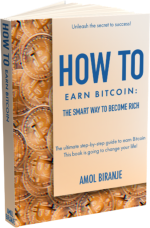

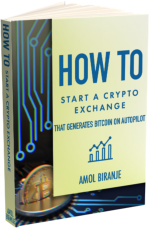

0 Comments